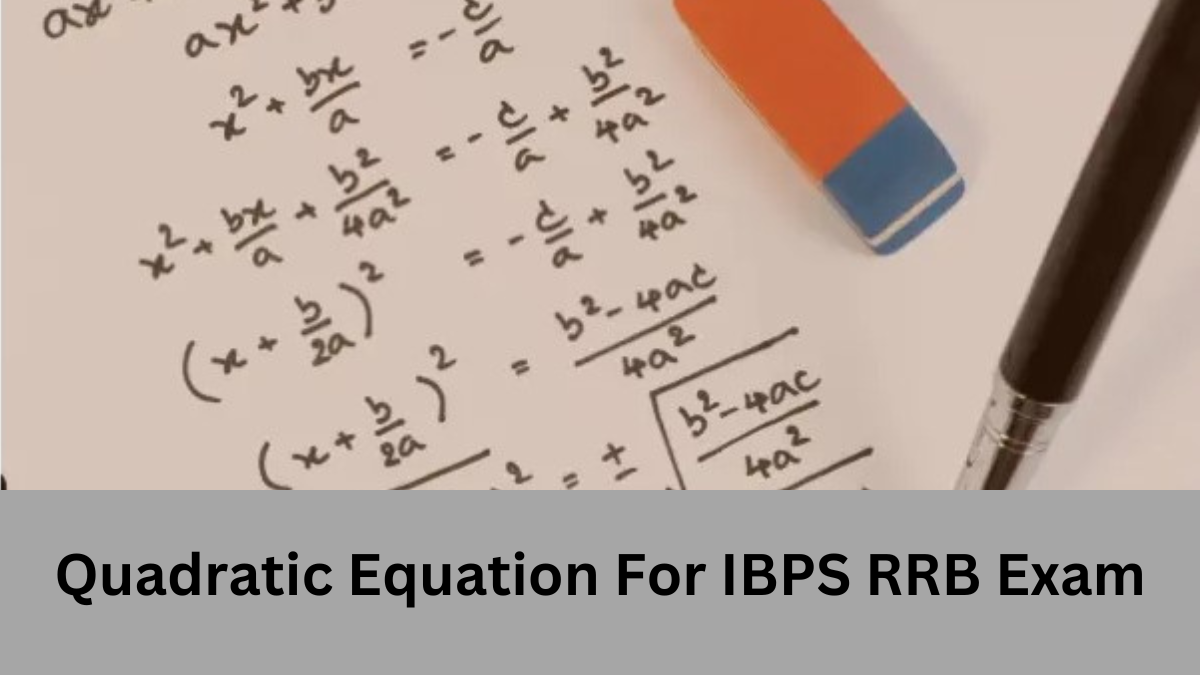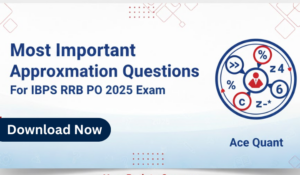Quadratic equations are a key part of the Quantitative Aptitude section in the IBPS RRB 2025 exam. These questions test a candidate’s ability to solve and compare two algebraic expressions to find the correct relationship between variables. Regular practice of quadratic questions can significantly improve speed and accuracy in the exam. In this article, we’ve provided important quadratic equation questions along with detailed solutions to help candidates strengthen this topic.
Quadratic Equation for IBPS RRB Exam 2025
A quadratic equation is a second-degree polynomial equation in one variable of the form:
ax² + bx + c = 0
where a, b and c are constants, and the x is variable. The x represents the unknown quantity, and the constants a, b and c determine the shape and nature of the equation.
Understanding the Quadratic Equation Formula
The quadratic formula is a formula that provides the two solutions to a quadratic equation. The Quadratic formula stands as the most straightforward method for determining the roots of a quadratic equation. In cases where certain quadratic equations resist easy factorization, the Quadratic formula offers a convenient and efficient means to swiftly calculate the roots.
The Quadratic Equation Formula
x = [-b±√(b2 – 4ac)]/2a
The Quadratic Formula is a rule that says that, in any equation of the form ax2 + bx + c = 0, the solution x-values of the equation are given by:
Solve using Quadratic formula 2x2 – 7x + 3 = 0
Solution:
Comparing the equation with the general form ax2 + bx + c = 0 gives,
a = 2, b = -7, and c = 3
Now, calculate the discriminant (b2 – 4ac):
b2 – 4ac = (-7)2 – 4 * 2 * 3 = 49 – 24 = 25
Now, substitute the values into the quadratic formula:
x1 = (-b + √(b2 – 4ac)) / (2a)
x1 = (-(-7) + √25) / (2 * 2)
x1 = (7 + 5) / 4 = 3
x2 = (-b – √(b2 – 4ac)) / (2a)
x2 = (-(-7) – √25) / (2 * 2)
x2 = (7 – 5) / 4 = 1/2
So, the roots of the equation 2x2– 7x + 3 = 0 are x1 = 3 and x2 = 1/2.
Factoring Quadratic Equations
Factoring quadratics is a technique used to represent the quadratic equation ax^2 + bx + c = 0 as a multiplication of its linear factors in the form (x – p) (x – q), where p and q represent the roots of the quadratic equation ax^2 + bx + c = 0.
Key Strategies for Quadratic Equation in RRB Exam
- Attentiveness: Be attentive and careful while solving the series especially because many candidates get perplexed while choosing the correct answer.
- Practice Regularly: Regular practice helps in quickly recognizing the common pattern
- For equations that cannot be solved by factorization, apply the quadratic formula or the method of completing the square.
- In word problems, carefully read the problem statement and identify the relevant variables and equations.
- Practice extensively with a variety of quadratic equation problems from previous years’ bank exam question papers and mock tests.
Quadratic Equations asked in IBPS RRB exams
Directions (65-69): In each of these questions, two equation (I) and (II) are given. You have to solve both the equations and give answer
Question 1:
I. 2x² – 13x + 20 = 0
II. 3y² – 16y + 21 = 0
(a) If x>y
(b) If x≥y
(c) If x<y
(d) If x≤y
(e) If x = y or no relation can be established between x and y
Question 2:
I. 5x² – 32x + 35 = 0
II. 4y² + 17y + 18 = 0
(a) If x>y
(b) If x≥y
(c) If x<y
(d) If x≤y
(e) If x = y or no relation can be established between x and y
Question 3:
I. x² – 34x + 285 = 0
II. y² – 40y + 399 = 0
(a) If x>y
(b) If x≥y
(c) If x<y
(d) If x≤y
(e) If x = y or no relation can be established between x and y
Question 4:
I. x² – 16x + 63 = 0
II. y² – 13y + 42 = 0
(a) If x>y
(b) If x≥y
(c) If x<y
(d) If x≤y
(e) If x = y or no relation can be established between x and y
Question 5:
I. x² × 4 = 64
II. y³ = 216
(a) If x>y
(b) If x≥y
(c) If x<y
(d) If x≤y
(e) If x = y or no relation can be established between x and y
Directions (76-80): Solve the given two equations and mark the correct option based on your answer
Question 6:
I. 2x² – 17x + 21 = 0
II. 3y² – y – 4 = 0
(a) If x>y
(b) If x≥y
(c) If x<y
(d) If x≤y
(e) If x = y or no relation can be established between x and y
Question 07:
I. 2x² – x – 45 = 0
II. 2y² – 5y + 3 = 0
(a) If x>y
(b) If x≥y
(c) If x<y
(d) If x≤y
(e) If x = y or no relation can be established between x and y
Question 08:
I. 2x² – 23x + 66 = 0
II. 3y² – 16y + 21 = 0
(a) If x>y
(b) If x≥y
(c) If x<y
(d) If x≤y
(e) If x = y or no relation can be established between x and y
Question 09:
I. 2x² + 16x + 24 = 0
II. 6y² + 13y + 6 = 0
(a) If x>y
(b) If x≥y
(c) If x<y
(d) If x≤y
(e) If x = y or no relation can be established between x and y
Question 10:
I. 12x² – 12x = 13x -12
II. 12y² – 13y + 3 = 0
(a) If x>y
(b) If x≥y
(c) If x<y
(d) If x≤y
(e) If x = y or no relation can be established between x and y
Directions (11-20): In each of these questions, two equations (i) and (ii) are given. You have to solve both equations and give an answer.
A) x > y
B) x < y
C) x = y or the relationship cannot be established
D) x ≥ y
E) x ≤ y
Question 11:
I. 3x2 – 24x + 36 = 0
II. 4y2 = y + 5
Question 12:
I. x2 – 2x – 63 = 0
II. y2 + 14y + 48 = 0
Question 13:
I. x2 + 15x + 54 = 0
II. y2 + 20y + 99 = 0
Question 14:
I. 3x + 7y = 53
II. 7x – 5y = 17
Question 15:
I. x2 – 27x + 180 = 0
II. y2 – 24y + 140 = 0
Question 16:
I. x2 – 11x + 30 = 0
II. y2 – 11y + 18 = 0
Question 17:
I. x2 + 3x – 10 = 0
II. y2 – 5y + 6 = 0
Question 18:
I. x2 – 5x + 4 = 0
II. y2 + 2y – 3 = 0
Question 19:
I. 3x + 5y = 21
II. 9x – 2y = 12
Question 20:
I. 4x2 + 16x – 20 = 0
II. 2y2 + 11y – 6 = 0
Directions (21-30): In each of these questions, two equations (i) and (ii) are given. You have to solve both the equations and give answer
(a) If 𝑥 < 𝑦
(b) If 𝑥 > 𝑦
(c) If 𝑥 ≥ 𝑦
(d) If 𝑥 ≤ 𝑦
(e) If 𝑥 = 𝑦 or no relation can be established
Question 21.
I. 2x² – 17x + 36 = 0
II. 3y² – 22y + 40 = 0
Question 22.
I. x² + 21x + 108 = 0
II. y² + 14y + 48 = 0
Question 23.
I. 2x² + 7x – 60 = 0
II. 3y² – 28y + 64 = 0
Question 24.
I. x² – 2x – 24 = 0
II. y² + 3y – 40 = 0
Question 25.
I. 𝑥3 = 729
II. 𝑦2 − 15𝑦 + 54 = 0.
Question 26.
I. x2 + 13x – 114 = 0
II. y3 = 216
Question 27.
I. x2 − 6𝑥 + 12 = 4
II. y2 + 4𝑦 − 10 = −13
Question 28.
I. 12×2 − 7𝑥 + 1 = 0
II. 20y2− 9𝑦 + 1 = 0
Question 29.
I. x2 + 26𝑥 + 165 = 0
II. y2+ 23𝑦 + 132 = 0
Question 30.
I. x2 + 𝑥 − 6 = 0
II. 15y2− 11𝑦 + 2 = 0
Solutions:
| Solutions | |||||||||
| 01 | 02 | 03 | 04 | 05 | 06 | 07 | 08 | 09 | 10 |
| e | a | d | b | c | a | e | a | c | b |
| 11 | 12 | 13 | 14 | 15 | 16 | 17 | 18 | 19 | 20 |
| a | c | d | a | c | c | e | d | b | c |
| 21 | 22 | 23 | 24 | 25 | 26 | 27 | 28 | 29 | 30 |
| c | a | d | e | c | d | a | b | e | e |



 Number Series Questions for Bank Exams
Number Series Questions for Bank Exams
 Most Important Approximation Questions f...
Most Important Approximation Questions f...
 Quadratic Equation Questions for SBI PO ...
Quadratic Equation Questions for SBI PO ...








